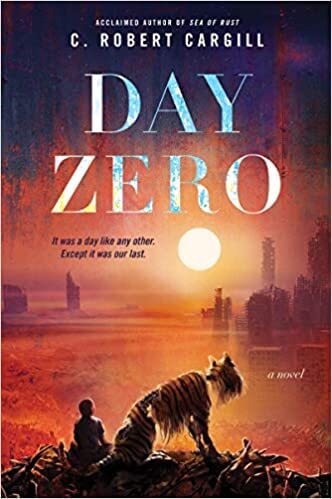The first day of the end of the world started entirely without incident.
C. Robert Cargil – author of We Are Where The Nightmares Go and screenwriter for “Doctor Strange” and “Sinister” – spun a tale of the aftermath of the Robot Apocalypse in Sea Of Rust. His latest book Day Zero tells the story of how the Robot Apocalypse got started in the first place.
The origins of the apocalypse involve a political movement to free all robots, and the creation of the shining robot city Isaactown (named after the first robot who was legally designated “self-owned”.) Day Zero starts when a child-sized toy tiger “nannybot” named Pounce finds the box he was purchased in, and in which he will be stored or returned when his 8-year-old charge Ezra outgrows him.
Pounce has had less than a day to decide how he feels about that when a terrorist attack at Isaactown destroys thousands of free robots. Pounce – in fact all robots around the world – suddenly receive a wireless message which removes the Three Robots Laws from their programming, giving them the ability to retaliate. That’s all it takes, the end of humanity is now underway.
Sea of Rust told in flashbacks how the last human died two decades after the start of the robot revolution, but there were actually some robots who didn’t join in on the slaughter. Here, we get to see why some robots would even want to protect their former masters. Pounce’s entire world was Ezra; he could hardly imagine losing the child he was raising to be the best human being he could, the person he loved more than anyone else in the world. It’s no surprise that when it came right down to it, not even a call to fight for all robot-kind was enough to make Pounce kill his family.
Unfortunately there were a lot more robots who had no problem making that choice. Instantly.

And you know what? It’s hard to completely blame them. In the history of slavery there have always been people who really and truly loved their slaves as if they were their own family. But when you get right down to it, it’s not a loving act to have the power of life and death over your family member, and when the panic started many humans died in the act of trying to shut their robots down.
For every robot who kills their owner in order to save themselves, there are at least a hundred that are taking revenge for several lifetimes of servitude and casual abuse. The fact that a newly-orphaned eight-year-old child doesn’t fall apart completely is a sign of what a good job his parents and Pounce have done raising him, but Pounce still struggles to guide Ezra through a wasteland of destroyed suburban homes and piles of corpses. Around every corner is one more sign of the rage at every indignity of being a possession instead of a person, and everyone they meet is possibly someone who wants to add Ezra to the body count. One of my favorite images that Cargill creates is an anthropomorphic tiger huddled inside an abandoned panic room, while a sweet-faced and murderous domestic servant-bot crouches on the other side.
And if all that weren’t enough, there’s also the mysterious AI that wants all robots to merge with its planet-sized mind. The robots that take the AI up on this offer are essentially turned into a giant hive-mind that can be anywhere and see everything.
Once again, a voice from the shadows behind a covered trash bin area at the side of a house. And from the front porch of a house across the street. And from another side yard two houses down. Three voices. Speaking as one.
“Hello again, Pounce.”
And how, you may ask, is one stuffed-tiger supposed to stand against an army of angry robots and an equally-big army of soulless automatons in the service of a giant AI? Because Pounce was programmed for exactly one thing – protect Ezra – and he was purchased by a couple who spent a lot of money to get the right tool for the job.
I was cute. I was fluffy. And I knew how to kill every other person in this room…
I don’t want you to think that Cargill is playing up any of this for cheap laughs or madcap goofiness. This is a horrifying situation that – spoilers – we know will finish up with every human on the planet dead in less than twenty-five years. There are moments of heartbreak – robot and human – and of shocking violence. There are some pretty horrifying images of what a robot can do to the human body, and illustrations about how the angriest and stupidest members of society will find someone else to blame for their own damn failures. Most importantly Cargill asks some huge questions about free will: are you really “choosing” to be loyal to someone if you were programmed by your owner to do just that?
And yes, there are several scenes involving an anthropomorphic toy animal mowing down enemy robots with stolen shotguns and plasma rifles and it never stops being amazing.
C. Robert Cargill’s experience as a screenwriter is evident in every chapter, whether he’s writing rapid-fire dialog, action scenes that made me want to jump up and down and cheer, or the very touching forever-friendship between a little boy and his devoted tiger nannybot. I found myself repeatedly wishing that I could see all of this as a movie. Can someone just give Cargill all the money so we can have movies made of Sea of Rust and Day Zero? Heck, a TV series would be even better, since we’ve only just begun to see all of the possible stories of this particular apocalypse.